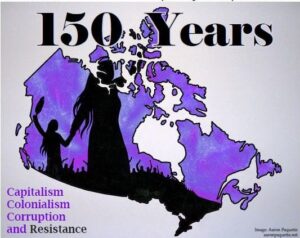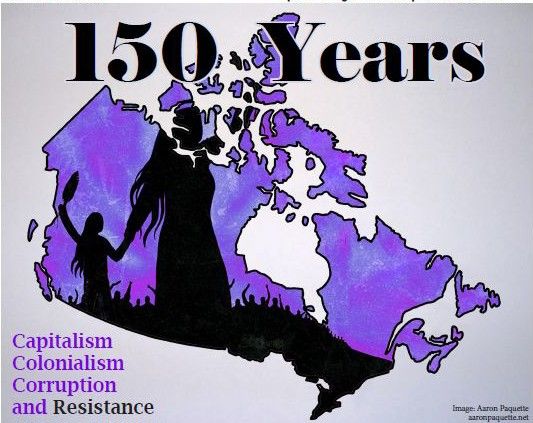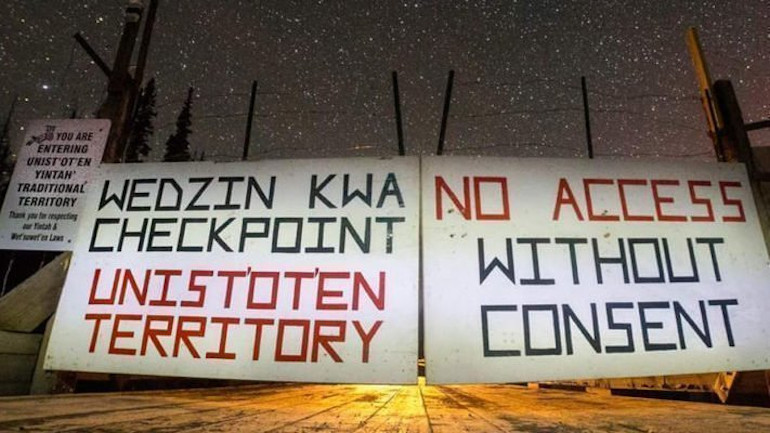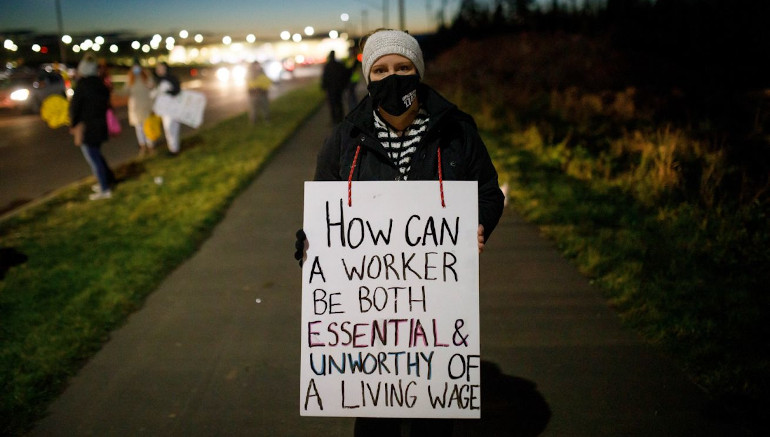 Canada was founded and formed by colonialism, capitalism and corruption countered by resistance. Unlike school history, this genuine history recognizes the central role of struggles of living people that shaped the Canada of today.
Canada was founded and formed by colonialism, capitalism and corruption countered by resistance. Unlike school history, this genuine history recognizes the central role of struggles of living people that shaped the Canada of today.
From the beginnings of what became Canada, the lands and waters were exploited for resources: whale oil, fish from the Grand Banks of Newfoundland and furs to the elites of Europe. Indigenous peoples aided European navigation, exploration and trade, but soon they became the unwilling victims of a colonial-settler state as their lands were stolen, they were forced onto tiny reserves and their culture banned.
The royal charter granted to the Hudson’s Bay Company (HBC) in 1670 gave it exclusive rights to trade and colonize all the lands containing rivers flowing into Hudson Bay. This area, called Rupert’s Land, was enormous, covering 3.9 million square kilometres, one third of the present area of Canada. None of the people who lived there had any say.
The Canadian state was founded in 1867 and from the beginning was dominated by the capitalist class. The drive for profits encouraged corruption. In 1870 the Canadian government gave the HBC, for the land it had acquired for nothing, one-twentieth of the most fertile of that land and $1.5 million.
Struggle was soon to follow. The Métis, living in the Red River area of Manitoba, had rights to the fur trade and land since the 1850s. However, the Canadian government deliberately ignored them in the deal with the HBC. When the Métis demanded their rights the Canadian government continued to ignore them. This led to the new Canadian state’s first major conflict, the Red River Rebellion.
Laying the Foundations of Canadian Capitalism
Indigenous peoples have lived in what is now Canada for time beyond memory, developing a diverse range of technologies and cultures, in societies that did not include the private ownership of land. Colonization took their lands, outlawed their cultures and exposed them to diseases to which they had no immunity, decimating populations.
Canada was a capitalist state from the start. The capitalist class decided the terms of Confederation, to meet their desire to build a stronger expansionist economy. While there was limited democracy, for adult, male, property-owning, British subjects, the appointed Senate was, in John A. Macdonald’s words, to curb the “democratic excesses” of the legislature.
The driving economic forces, and source of enormous profits, were land speculation and resource extraction. Early on, a strong, and monopolized, financial and banking system emerged.
Agriculture, and later manufacturing, employed most of the population.
Building a national transcontinental railway, the Canadian Pacific Railway (CPR), realized the aim of a nation from sea to sea. Its construction was mired in corruption leading to MacDonald’s defeat in 1873. The CPR, owned by seven men, was given 100,000 square kilometres of land (nearly twice the area of Nova Scotia).
The railway, after MacDonald deliberately starved the Indigenous peoples off their land, opened the west to settlement. The CPR ensured it captured profits from the settlers, as it owned much of the best land for farming and building towns.
Manufacturing peaked during the second World War, accounting for 29% of GDP; by 2014 it had declined to only 10.6%. The Canadian economy today is dominated by the resource industries, finance, construction and the services necessary for wealth accumulation such as health, education, communications and transportation.
After World War II, the Canadian working class through struggle won wide-ranging reforms, such as social assistance, pensions, Workers’ Compensation, Family Allowances and the construction of social housing. Real wages doubled between 1945 and the late 1970s. For the first time most Canadians had a half-decent living standard.
However, the capitalist class wanted more profits so from the early 1980s, neoliberalism pushed back on these hard-won reforms. While the cuts and austerity are not as deep as in many countries, poverty, homelessness, inequality and insecure work have all increased.
Resistance
This year, a history of a harmonious society developing into modern Canadian society will be presented. The reality is one of constant struggle and resistance to the ruling class as the majority of Canadians fought for a better life.
A key feature shaping Canada is the existence of Québec with its separate language, culture and history. Québec is a separate nation, yet part of the federal state of Canada. While the Church acquiesced to English rule, there was a long deep stream of resistance.
However, until the Quiet Revolution of the 1960s and 1970s, Québec was the most right-wing province with the Catholic Church wielding enormous power. The Quiet Revolution transformed Québec with an explosion of unionization, the separation of Church and State, and major social and workplace reforms. During the 1960s a strong nationalist movement was forged, culminating in the 1980 and 1995 referendums.
The Canadian ruling class has brought in waves of immigrants for economic reasons. They came from misery, hoping for a better life, but often facing discrimination and misery. The Irish fleeing the famine, travelled in “coffin ships,” which had a mortality rate of 30%, worse than most slave ships. They then faced discrimination, cholera and back-breaking work.
The CPR brought 17,000 Chinese to build the western railway. They did the most dangerous work and received less than half of white workers’ low pay. Economic interests still dominate Canada’s immigration rules and with elements of racism in many laws, such as minimum wage regulations not covering farm workers or the lack of rights for live-in nannies.
Women’s suffrage groups existed since the 1870s, but the right to vote for all women was only finally won with Quebec in 1940. The struggle for women’s reproductive rights spanned many decades. The right to legal abortions was won in 1988 through the activism and determination of women over many decades, and there are still limitations. Today women are nearly half the workforce, but receive lower pay then men and face constant sexual harassment.
Working class struggles are central to the shaping of Canada. Although the Great Depression stunned the working class, it gave rise to the Cooperative Commonwealth Federation (CCF) – the predecessor to the NDP. The CCF-NDP has shaped Canada by helping to win public health and other social benefits. Its existence, along with Québec, have forced the Canadian ruling class to be more cautious in its neoliberal assault out of fear of political resistance.
As the depression receded, workers flooded into unions. By the end of 1937, 650,000 Canadians joined industrial unions. Wartime economic growth, strong union militancy and support for the CCF forced the ruling Liberal government to recognize the right to organize and collectively bargain. Militancy remained high until the 1970s and strike action won for public sector workers the right to organize, bringing many women into the organized labour movement.
Throughout history, Indigenous people have resisted government policies and incursions on their lands. They vehemently opposed Pierre Trudeau’s 1969 White Paper aimed at assimilation. In many battles, Indigenous people have fought for control of land and resources, better conditions on reserves and against resource extraction. In spite of the constant efforts of the Canadian state to eradicate Indigenous peoples, they have more than survived. They are the fastest growing section of Canadian society and are resisting.
The first military actions of the Canadian state were against Canadians, crushing the Métis in Saskatchewan. The War Measures Act was used in Québec in 1970, with over 450 people detained.
In 1995 at Gustafsen Lake, 20 Indigenous people occupied sacred land. The RCMP responded with 400 armed officers, backed by five helicopters, two surveillance planes and nine armoured personnel carriers, and fired 77,000 of rounds of ammunition. The deployment cost $5.5 million.
The Communist Party was banned in Canada, its leaders imprisoned. In Québec, the Padlock Law was in operation until 1957. Workers regularly faced militia, police and the army in their battles for union rights and better pay and were fined, imprisoned, assaulted and sometimes murdered by the state.
Looking Ahead
Canadians sense that life here is better than in most of the world, without wars, famines, brutal austerity or Donald Trump. However, this stability and security is skin-deep and rests on weak foundations, with growing trends towards greater instability and economic and political shocks.
Canada remains broadly socially progressive and while unions have been pushed back, the working class has not suffered serious defeats. There are small signs that the working class is fighting back.
Colonialism and capitalism remain major obstacles to a future where Indigenous rights are respected, racism is eradicated and the struggles for a just and sustainable world are won. The working class has the power to liberate humanity and live in harmony with the natural world.




